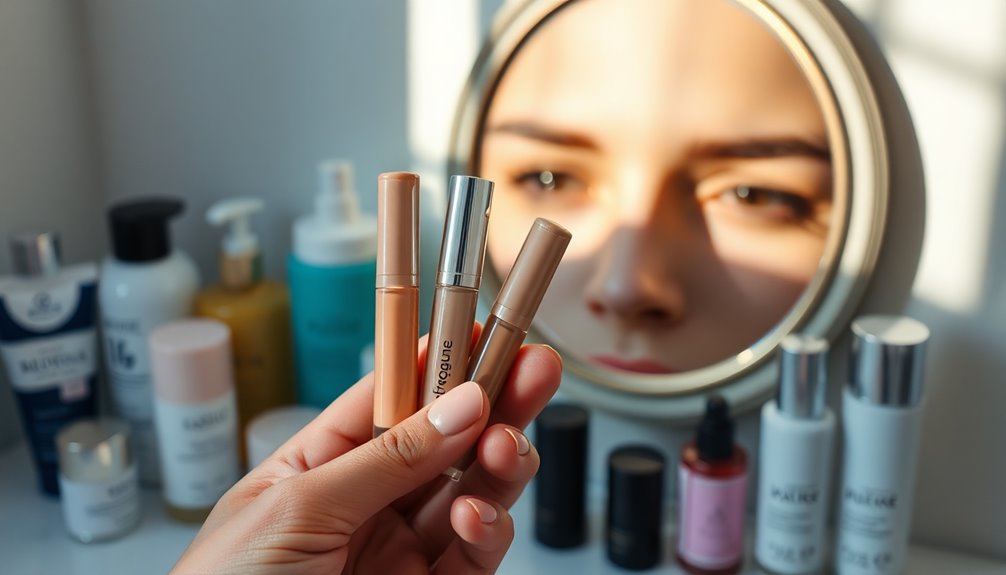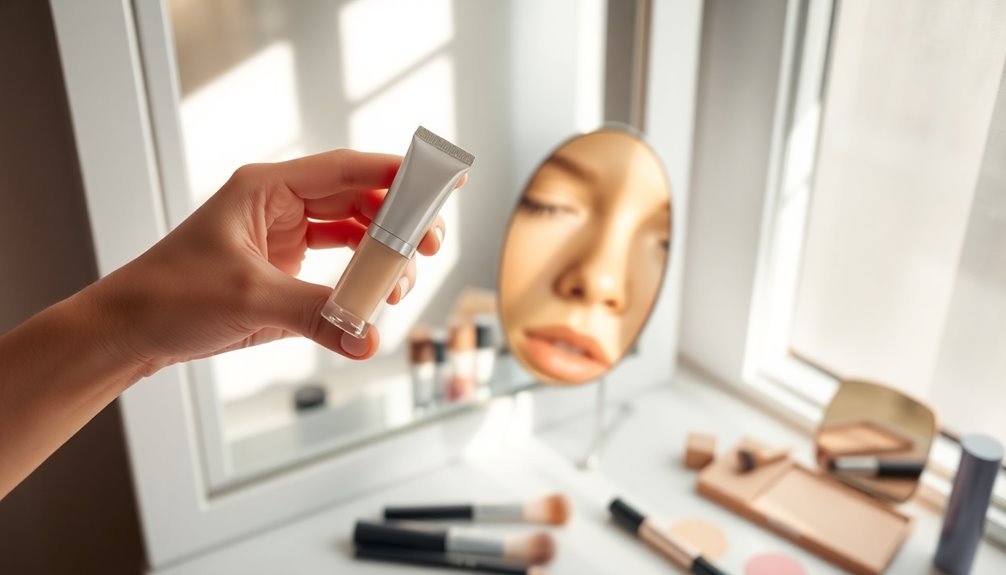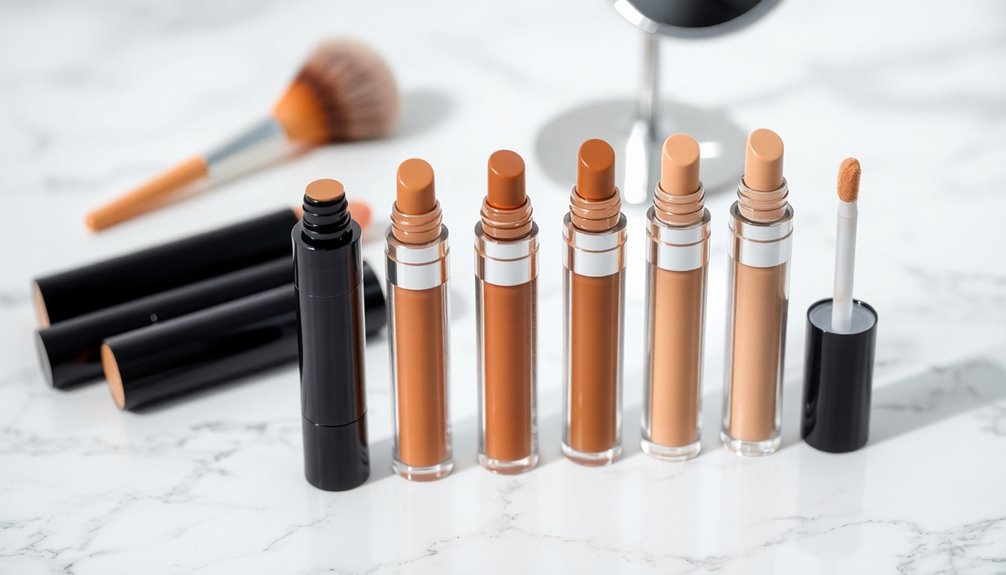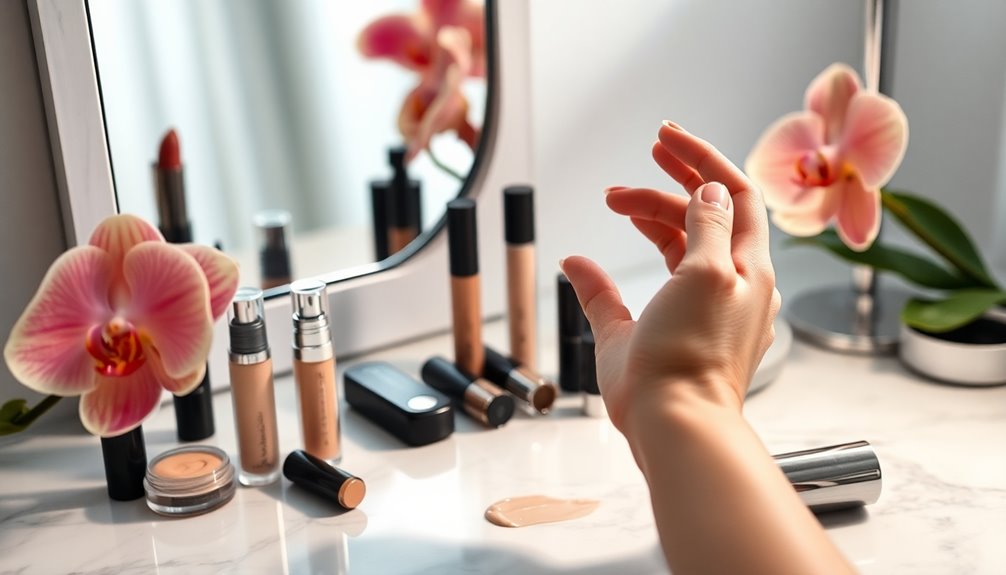To choose the right concealer for dark circles, identify your skin tone and undertones. Look for a shade one to two shades lighter than your skin. Use peach or orange undertones for bluish circles, depending on your skin tone. Apply concealer in a triangular shape under the eyes and blend with a damp sponge. Don't forget to set it with a lightweight powder to prevent creasing. Keep going to discover specific product recommendations for your skin type!
Key Takeaways
- Identify your skin undertone (warm, cool, neutral) to select a concealer that complements your natural coloring.
- Choose a concealer one shade lighter than your skin tone for effective brightening and coverage of dark circles.
- For fair skin, opt for peach undertones; for medium skin, select peach or orange; for dark skin, use orange undertones.
- Apply concealer in a triangular shape and blend gently for a natural finish, using a damp sponge or fingertip.
- Set the concealer with a lightweight translucent powder to prevent creasing and maintain coverage throughout the day.
Understanding Dark Circles and Their Causes

Understanding dark circles under your eyes requires looking beyond just fatigue. While lack of sleep is a common cause, there are several factors at play.
Genetics can predispose you to dark circles, and as you age, your skin thins, revealing underlying blood vessels. Conditions like allergies, dehydration, and excessive sun exposure can worsen the appearance, leading to increased pigmentation. Additionally, dietary fiber intake can influence overall skin health, helping to combat issues related to dehydration.
The delicate skin around your eyes shows these changes more prominently. Realizing these causes can help you choose the right concealer to address discoloration effectively. Incorporating regular skin treatments can also significantly improve the overall texture and appearance of the under-eye area.
Instead of just masking them, opt for a concealer that targets the root issues of dark circles. A well-chosen concealer can help you achieve a brighter, more refreshed look effortlessly.
The Importance of Matching Undertones

Understanding your skin's undertones is essential when choosing a concealer for dark circles. By grasping the basics of color theory, you can select a shade that neutralizes the bluish or brownish tones effectively. This way, you'll achieve a seamless look that enhances your natural beauty. Additionally, using a concealer with antioxidants that combat oxidative stress can provide added benefits for your skin's health. Incorporating products rich in vitamins A, C, and K can further support your skin's overall appearance and vitality.
Identifying Skin Undertones
How can you choose the right concealer for dark circles if you don't know your skin undertone? Understanding whether your undertone is warm, cool, or neutral is key to achieving a perfect concealer match.
You can determine your undertone with the vein test: if your veins appear greenish, you likely have a warm undertone; bluish veins suggest a cool undertone, while a mix indicates neutral. Additionally, knowing your skin's astrological traits may give insight into your unique beauty.
For dark circles, opt for a concealer that's one shade lighter than your skin tone. Peach undertones work well for lighter skin, while orange is ideal for darker tones to counteract blue.
Matching your concealer's undertone to your skin guarantees a seamless blend, enhancing your complexion and effectively concealing dark circles. Additionally, maintaining a balanced diet rich in essential fatty acids can support overall skin health, which may improve the appearance of dark circles.
Color Theory Basics
Color theory plays a vital role in selecting the right concealer for your needs, especially when it comes to matching undertones. By understanding color theory, you can effectively neutralize dark circles and enhance your complexion.
Here are three key points to take into account:
- Identify Your Undertones: Determine if your undertones are warm, cool, or neutral to find the right shade match.
- Use Color Correctors: Employ peach or orange concealers for bluish dark circles, while green and lavender can address redness or sallow skin respectively.
- Choose the Right Shade: Always opt for a concealer that's one shade lighter than your skin tone, ensuring it complements your undertones for a seamless finish.
Selecting the Right Concealer Shade

When it comes to selecting the right concealer shade for dark circles, finding the perfect match can make all the difference. Choose a concealer that's one shade lighter than your natural skin tone to brighten the area effectively.
If you have a light skin tone, look for peach undertones to counteract blue tones. For darker skin tones, orange undertones work best. Eucalyptus oil is known for its decongestant effects, which can also help with dark circles caused by sinus congestion.
Always test concealer shades in natural light on your inner wrist or jawline to guarantee they complement your skin's undertones.
Remember, it's vital to select a concealer that matches your undertone—cool for pink skin and warm for yellow or golden skin.
If needed, consider using a peach or orange color corrector before applying your concealer. Additionally, imagination mobilizes mental potential, fostering creativity that can help you experiment with various makeup techniques.
Techniques for Applying Concealer to Dark Circles

Achieving a flawless look for dark circles starts with the right application techniques. Follow these steps for the best results:
Achieving a flawless look for dark circles begins with mastering the right application techniques.
- Choose the Right Concealer Shade: Select a concealer one to two shades lighter than your skin tone to brighten the under-eye area. This technique is similar to using bottled lemon juice for its convenience and consistency.
- Apply in a Triangle: Use a triangular shape with the base along the lower lash line and the point toward your cheekbone. This enhances brightness and lift.
- Blend Gently: Use a damp makeup sponge or your fingertip to tap and blend the concealer. This guarantees a smooth finish that reflects your natural skin texture while avoiding harsh lines. Additionally, consider using long-lasting formulas to ensure your concealer stays in place throughout the day. Finally, don't forget to set the area with lightweight translucent powder to prevent creasing after you apply foundation.
Color Correcting for Optimal Coverage

After mastering the application techniques for concealer, you can take your coverage to the next level with color correcting.
To effectively neutralize the bluish tones of dark circles, use a peach color corrector for lighter skin tones or orange for deeper ones.
Once you've applied the corrector, choose a concealer shade that's one shade lighter than your skin tone to enhance brightness.
Remember to layer the corrector and concealer gently—start with a small amount and build up coverage as needed to avoid a cakey look.
Opt for a creamy concealer formula that hydrates and blends well, ensuring it won't settle into fine lines.
This method will give you a seamless, radiant finish under your eyes.
Testing Concealer in Natural Light

To guarantee you choose the perfect concealer for your dark circles, testing shades in natural light is essential. This environment reveals the true color match against your skin tone, ensuring you find a shade that complements your undertone effectively.
Here are three key tips for testing concealer:
- Swatch on Your Jawline: Apply the concealer on your jawline or inner wrist to see how it blends with your skin.
- Check Throughout the Day: Natural light changes, so evaluate the concealer at different times to see how it looks.
- Avoid Dim Lighting: Steer clear of testing in poorly lit areas, as they can mislead your shade selection.
Recommended Concealers for Different Skin Tones

When choosing the right concealer for dark circles, understanding your skin tone and undertones is essential.
For fair skin with cool undertones, try No7 HydraLuminous Dark Circle Concealer in Shade 1.
If you have a medium skin tone with warm undertones, look for a peach or orange undertone concealer to counteract bluish circles.
Dark skin tones with warm undertones should consider No7 HydraLuminous Dark Circle Concealer in Shade 9 for great coverage and a radiant finish.
The Maybelline Instant Age Rewind Concealer is also a fantastic choice, as it offers a variety of shades for both cool and warm undertones.
Frequently Asked Questions
How Do I Find the Right Shade of Concealer for Dark Circles?
To find the right shade of concealer for your dark circles, start by selecting a tone that's one shade lighter than your natural skin color.
If you've got lighter skin, look for peach undertones; for darker skin, opt for orange undertones.
Testing shades in natural light is essential for a perfect match.
Remember, liquid concealers offer buildable coverage, while cream formulas can provide more opacity for stubborn areas.
Don't forget to set it with powder!
Which Concealer Shade Is Best for Dark Circles?
When picking a concealer shade for dark circles, opt for one shade lighter than your skin tone.
If you have lighter skin, go for a peach-toned concealer; for darker skin tones, choose one with orange undertones to neutralize blue hues.
Make certain the concealer has a creamy texture for hydration and buildable coverage.
Testing shades in natural light helps you find the perfect match that seamlessly blends and effectively conceals your dark circles.
What Color Concealer Is Best for Dark Circles?
When you're picking a concealer for dark circles, consider colors like peach or orange if you have light to medium skin tones, as they'll counteract the blue tones effectively.
For deeper skin tones, opt for a concealer with deeper orange or red undertones to neutralize the discoloration.
Always choose a shade that's one lighter than your foundation to brighten the area, and make sure to test in natural light for the best match.
What Concealer Is Best for Dark Circles Under Eyes?
You might think any concealer will do, but the right one makes all the difference.
For dark circles, opt for a hydrating formula that brightens and smooths, like No7 HydraLuminous. Choose a shade lighter than your skin tone with peach or orange undertones to neutralize bluish tones.
Apply it gently with your fingertip to blend seamlessly, and set it with a lightweight powder to keep it looking fresh all day.
Conclusion
So, you've mastered the art of choosing the perfect concealer for those pesky dark circles—only to realize that sleep is the ultimate cure. But hey, at least now you can hide your weariness like a pro! With the right shade, technique, and a little color correction, you can look wide awake even when you've just binge-watched your favorite series until dawn. Remember, while concealers can work wonders, nothing beats a good night's rest—if only that were as easy to apply!










